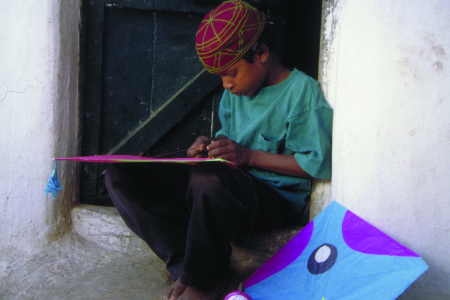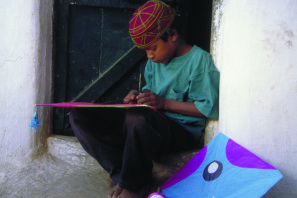Ours is a single-form entry Primary school in a densely populated urban location. We have a mix of pupils from diverse backgrounds, though the majority are white British. We trialled this activity over the course of a year with a Year 3 class (age 7–8), to see if our focus on countries around the world would address ideas of difference.
 We started at the beginning of the academic year, using the photo of the boy with a kite, and asking pupils simply to list similarities and then differences. Pupils were already divided into groups by the tables that they work at, so I used those groups to try slightly different methods. One group had paper with a line down the middle and similarities written on one side and differences on the other. Another group were asked to list similarities on one piece of paper, and then differences on another, and a further group were asked to start with differences and then list similarities. A final group were asked to mind map any similarities and differences they could think of on one piece of blank paper. I was interested to see how the framing of the question would affect their responses. Interestingly, it made little difference, which may be to do with the fact that they all knew the objective of the activity was to do with similarities and differences. There were slightly more similarities from the group that started by listing those first, but I don’t think it was significantly more.
We started at the beginning of the academic year, using the photo of the boy with a kite, and asking pupils simply to list similarities and then differences. Pupils were already divided into groups by the tables that they work at, so I used those groups to try slightly different methods. One group had paper with a line down the middle and similarities written on one side and differences on the other. Another group were asked to list similarities on one piece of paper, and then differences on another, and a further group were asked to start with differences and then list similarities. A final group were asked to mind map any similarities and differences they could think of on one piece of blank paper. I was interested to see how the framing of the question would affect their responses. Interestingly, it made little difference, which may be to do with the fact that they all knew the objective of the activity was to do with similarities and differences. There were slightly more similarities from the group that started by listing those first, but I don’t think it was significantly more.
Putting all the class’s responses together showed that about 39% of their responses were similarities. Mostly, they focused on the child’s appearance as different. This was the category with the strongest focus on difference, with more than three times the number of differences in appearance than similarities.
This is an example from one group of answers relating to appearance:
Similarities; he is wearing a hat, clothes, he has feet, he’s got toys, trousers,
Differences; he’s got a different hat, he’s a different colour, he doesn’t wear socks, dirty, poor, woolly hat, short hair, street-boy, he’s much more poor, he’s got brown skin, ragged, his hat, he has different clothes. bare feet, dusty, bit weird, looks lonely, really poor, his skin is different, he’s from Africa.
We were quite shocked by this as there are several children of Asian heritage in the classroom and so we had expected less focus on skin colour as a difference.
We decided to refocus our year-long work on different countries around the world, to make sure we were looking at similarities and not reinforcing difference. We also wanted to combat the idea that everyone in Africa is poor. We had already planned for each year group to focus on one country each from around the world, but realized that only one of the countries was in Asia and one in Africa, and the rest were in Europe or Australia. We decided to add a second country for each year group. This change was a bit last minute, but teachers were happy to give it a try. We ended up with every year group looking at a country in Africa as well as their original country.
We looked at something from each country in every curriculum area. In Science we looked at examples of different energy production in each country; hydroelectric dams in India, for example. We looked at what food was grown and exported from each country, and we read stories from each country in Literacy. Each class produced displays of information about their countries and because each class had two countries to focus on, we all explored similarities between those two countries. This produced some really interesting discoveries, like the link between China and some South American countries through panpipes and bamboo flutes!
We also linked it to our Rights Respecting work, and looked at how rights were the same in all the countries. We found images of children playing football from every country, and of children swimming, and linked it to the right to play.
Furthermore, we used Google Earth to zoom in to each country and look for similarities in buildings or green spaces, and to find capital cities and forests and beaches if they had them. The children really loved this and it tied nicely into Geography work.
At the end of the school year we repeated the What’s the same, what’s different activity. By this point, all the staff wanted to do the activity to see if their class was better than the Year 3s had been at the beginning of the year.
We found that most classes had a ratio of 60% similarities to 40% differences on average. We were shocked at how much change had taken place, even for the younger pupils.
Interestingly, the change in appearance comments moved to about 50/50: they still thought he had no shoes and was in Africa, but they also recognized similarities in clothing.
Similarities: clothes, we wear hats, I wear a hat like that to mosque, hat, clothing, black hair, hats, clothes, hats, clothes, wears a t-shirt and trousers, hat, clothes, clothes, hat,
Differences: no shoes, hat, I don’t wear a hat like that, different hat, bare feet, no shoes outside, skin colour, no socks or shoes,
The most significant change was in the category of hobbies and activities. The first time around, the Year 3s had hardly mentioned anything that would fit in to this category. Now, it was full of similarities.
Similarities: toys, using pencil and pen, kites, writing, plays with friends, has a TV, kite, flying kites, going to the park, drawing, seeing friends, writing, he’s not poor because otherwise he wouldn’t be able to afford the materials for his kite, sitting on a door step, football, after school clubs, he likes drawing, he might have pets, might have the same drinks, he might be quite wealthy or quite poor, kites
Differences: We usually buy kites that say made in…, his family might be poor and not have a TV, probably poor, I don’t play with kites
One class who had been doing lots of work on Philosophy for Children had a small number of responses that were really noted by the team as being great evidence of critical thinking:
maybe we should put things in the middle cos they could be similarities or differences
it’s important not to be certain, because we don’t know him
I think there should be another box for things that we don’t know
well, he might be the same or different about anything, you can’t really tell
We were really encouraged by this, and our plan now is to get some Philosophy for Children training for more members of staff so that we can use it to deliver Global Education better. We think it will underpin all our global learning and be a great way to deal with the tricky or controversial bits.
We are going to start to introduce a news bulletin board in the school hall, with topical news stories from around the world, and focus on positive ones in particular, and this might be a good stimulus for Philosophy for Children sessions in the future.
Useful websites
http://positivenews.org.uk/ Inspiring and solution-focused news stories from all over the world
http://www.ourlittleearth.com/ Bi-monthly edition of world events and global news for kids


